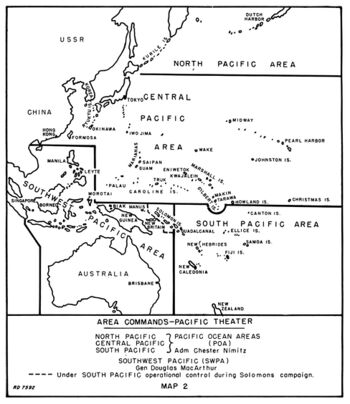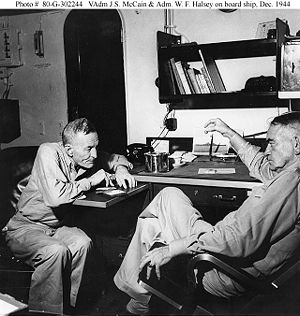William Halsey
William F. "Bull" Halsey (1882-1959) was a fleet admiral of the U.S. Navy, a colorful and inspirational combat leader in the Second World War. He was also quite controversial in terms of his ability at the level of fleet command, especially at the Battle of Leyte Gulf. One of his most authoritative biographers, E. B. Potter, had begun his work tending to believe that argument, but eventually saw him as
a man not without shortcomings but with qualities of leadership, courage, judgment, good will and compassion that utterly outweigh his faults.[1]
As Halsey points out in his autobiography, "Bull" was the nickname of the press corps, not the Navy. Named for his father, he was first called "Old Bill", then "Bill" in the Navy, and "more recently I suppose it is inevitable for my juniors to think of me, a fleet admiral and five times a grandfather, as "Old Bill" Now that I am sitting down to my autobiography, it is Bill Halsey whom I want to get on paper, not the fake, flamboyant "Bull.""[2] It is a Navy legend, however, that an officer, entering Halsey's darkened command information center during a battle, muttered "is that old goat here?" and received a thunderous response, "Who are you calling old?
Early life and career
Born into a Navy family, he graduated from the United States Naval Academy in 1904, specializing in torpedo warfare. "He commanded the First Group of the Atlantic Fleet's Torpedo Flotilla in 1912-13 and several torpedo boats and destroyers during the 'teens and 'twenties. Lieutenant Commander Halsey's First World War service, including command of USS Shaw (Destroyer # 68) in 1918, was sufficiently distinctive to earn a Navy Cross."
In 1922-25, Halsey served as Naval Attache in Berlin, Germany and commanded USS Dale (DD-290) during a European cruise. [3]
Preparing for WWII
Halsey recognized, earlier than other officers, the significance of naval aviation. In 1932, he left destroyer duty, in which he had spent all but one year of his sea duty. He first attended the Naval War College, and then the Army War College, which was then in Washington, DC and focused on the level of national strategy.
Entering aviation
Ernest J. King, then head of the Navy's Bureau of Aeronautics, offered him command of the aircraft carrier USS Saratoga if he would qualify as aircrew by taking the aviation observer course. He did not immediately agree but asked his wife's opinion, and she said she would agree if Admiral William Leahy, then head of personnel for the Navy, agreed. Leahy blessed the idea.
Arriving at the air training center at Pensacola, Floria in July 1934, he changed from the observer to the pilot curriculum. Much older than the usual student pilot, he noted that "my eyes could not pass the tests for a pilot, and how I managed to be classified as one, I honestly don't know yet, and I'm not going to ask." [4]
After his certification of a pilot, he indeed took command of Saratoga, until 1937, when he became commandant at Pensacola. He was selected as a rear admirall in 1937, waiting for an opening fifteen months later.
Force command
In May 1938, he took command of Carrier Division 2 and gained experiene in multiple-ship operations.
Senior command
His senior command experience was at three levels:
- Pearl Harbor to 28 May 1942: task force command; then on the sick list
- 18 October 1942 to 15 June 1944: commander of the South Pacific Area
- 16 June to end of war: Third Fleet command
Task Force
South Pacific Area

After being medically approved to return to duty, he was named to command a carrier task force in the South Pacific Area. Since the ships were still being readied, he began a familiarization trip to the area on 15 October 1942, arriving at the Noumea area headquarters on the 18th. After Pacific commander Chester W. Nimitz concluded that VADM Robert Ghormley had become dispirited and exhausted. As Halsey's aircraft came to a stop at Noumea, Ghormley's flag lieutenant met him before he could board the flagship, giving him a sealed envelope containing a message from Nimitz:
YOU WILL TAKE COMMAND OF THE SOUTH PACIFIC AREA AND SOUTH PACIFIC FORCES IMMEDIATELYHalsey was "apprehensive" because he "knew nothing about campaigning with the Army, much less with Australian, New Zealand, and Free French forces. Second, although I knew little about the military situation in the South pacific, I knew enough to know it was desperate...lastly, I was regretful because Bob Ghormley, whom I was relieving, had been a friend of mine for forty years."[5]
Carl Solberg, an intelligence officer on Halsey's staff, wrote that Halsey was kept ashore at Noumea, after his early task force leadership, to provide motivation for demoralized U.S. forces in the South Pacific. Once they began to operate independently, the new system of fleet command was instituted.[6]
Fleet command
In the Pacific War, the United States obtained much better usage of its warships than did the Japanese, as most of the combat vessels stayed at sea, with extensive logistical support. For the same set of ships, however, there were two command staffs. One set would conduct an operation from the flagship, while the other would stay on shore to plan the next operation.
When the operating warships were under Halsey, they were designated United States Third Fleet. United States Fifth Fleet was their designation when commanded by Vice Admiral Raymond Spruance. Reflecting the alternation of the top command between Halsey (Third Fleet) and Spruance (Fifth Fleet), there were two major type-specific task forces that kept the same ships but changed numbers, not necessarily acting as an active command level in a particular engagement.
- TF 38/TF 58: Fast Carriers Pacific Fleet, under VADM Marc Mitscher
- TF 34/TF 54: Battleships Pacific Fleet, under VADM Willis Lee
Fleet Admiral and later life
Halsey was the last Navy officer promoted to the special rank of Fleet Admiral. Four such promotions were authorized for the Navy, although William Leahy was arguably a White House rather than Navy officer.
Halsey's peer, Raymond Spruance, as or more highly respected in the Navy than Halsey, was blocked for the promotion by Congressional politics.
References
- ↑ E. B. Potter (1985), Bull Halsey, U.S. Naval Institute, ISBN 0870211463, p. xiii
- ↑ William F. Halsey and J. Bryan III (1947), Admiral Halsey's Story, McGraw-Hill, p. 1
- ↑ Fleet Admiral William F. Halsey, Jr., USN, (1882-1959), Navy Heritage and Historical Command (formerly Naval Historical Center)
- ↑ Admiral Halsey's Story, p. 56
- ↑ Admiral Halsey's Story, pp. 109-111
- ↑ Carl Solberg (1995), Decision and dissent: with Halsey at Leyte Gulf, U.S. Naval Institute, ISBN 1557509710, pp. 14-15


